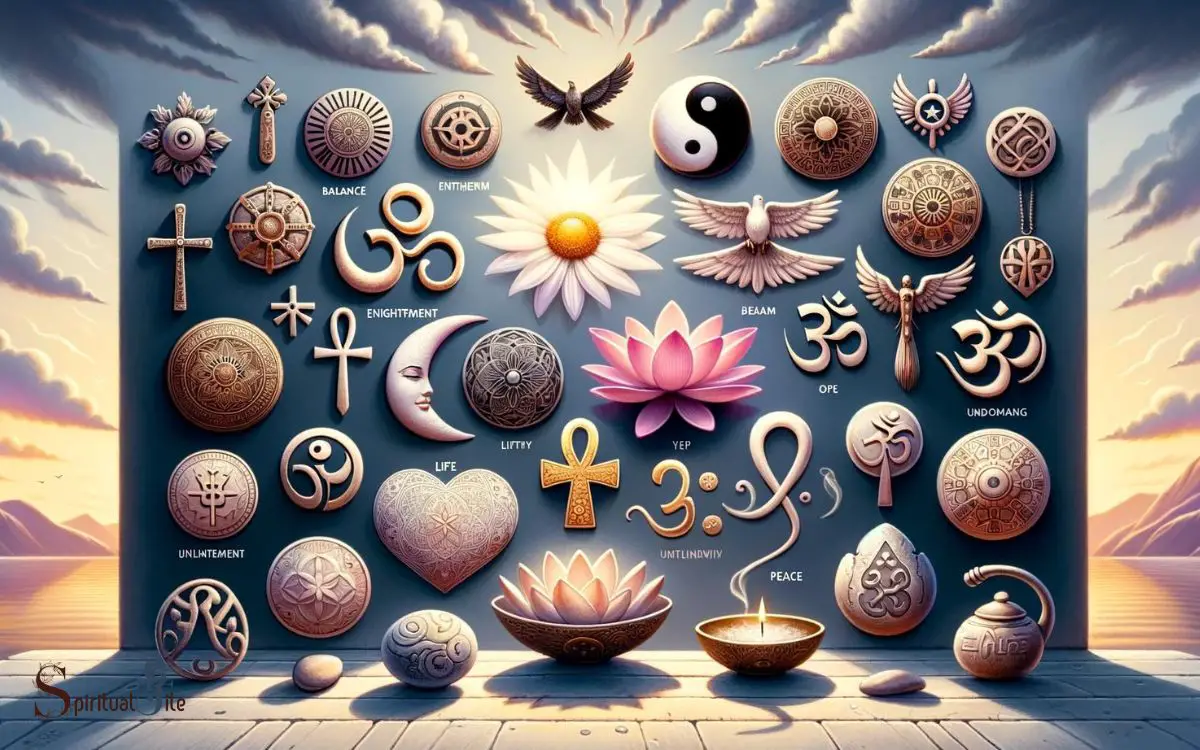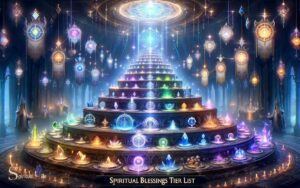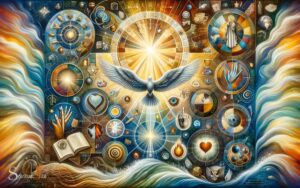Spiritual Symbols and Meanings List: Explanations!
We’ve all encountered symbols that seem to hold a deeper, unspoken significance. Whether it’s the gentle flutter of a butterfly’s wings or the intricate pattern of a mandala, these spiritual symbols often carry profound meanings that resonate with our inner selves.
Our ‘Spiritual Symbols and Meanings List’ aims to shed light on these enigmatic symbols and their rich significance. From animal symbols to celestial symbols, we seek to explore the diverse tapestry of spiritual symbolism.
By delving into these universal symbols, we hope to provide insight into the profound connections between the physical and spiritual realms. Join us on this journey of understanding and discovery as we unravel the hidden meanings behind these ancient and powerful symbols.

Key Takeaway
Animal Symbols
Here are nine animal symbols with deep spiritual meanings. Animals have long been significant in various cultures, representing qualities and characteristics that hold spiritual significance.
The dove, for instance, is a symbol of peace and divine guidance, while the elephant embodies strength, wisdom, and longevity. The butterfly symbolizes transformation and rebirth, and the wolf represents instinct, intelligence, and freedom.
The owl is often associated with wisdom and intuition, and the lion signifies courage, protection, and authority. The snake is a symbol of transformation and healing, and the deer embodies gentleness, compassion, and a nurturing spirit.
Lastly, the bear represents strength, introspection, and healing. These animal symbols hold deep spiritual meanings that connect us to nature and the divine.
Plant Symbols
Plants hold a myriad of spiritual symbols that have been revered across cultures and traditions for their profound meanings and connections to the natural and divine realms.
Floral Symbolism
- Flowers: Often represent growth, beauty, and the fleeting nature of life.
- Trees: Symbolize strength, wisdom, and the interconnectedness of all life.
Plants have long been recognized as powerful symbols in various spiritual and religious contexts. Their growth, resilience, and interconnectedness with the natural world make them potent representations of life, renewal, and the divine.
Understanding the symbolic meanings of plants can deepen our connection to the natural world and offer insights into the mysteries of existence.
Sacred Geometry
Moving from the realm of plant symbols, we delve into the intricate world of sacred geometry, where patterns and shapes hold profound significance across various spiritual traditions.
Sacred geometry encompasses timeless geometric forms such as the vesica piscis, flower of life, and the golden ratio. These shapes are believed to represent the fundamental building blocks of the universe and are thought to hold divine and transformative properties.
The circle, for example, symbolizes unity and infinity, while the triangle embodies balance and harmony.
In various spiritual practices, these geometric symbols are used to create mandalas, sacred spaces, and meditation tools to connect with higher consciousness and the cosmos.
Understanding the symbolism and energy behind these geometric forms can lead to profound spiritual insights and experiences.
Elemental Symbols
Alright, let’s talk about elemental symbols. We’ll cover Earth, Air, Fire, Water, and their symbolism in nature. These elements hold deep spiritual significance and are found in various cultural and religious traditions.
Earth, Air, Fire, Water
As humans, we have long connected to the elemental symbols of Earth, Air, Fire, and Water in our spiritual and symbolic practices.
These elements hold deep significance across various cultures and belief systems, representing fundamental aspects of existence and the natural world.
Let’s delve into their meanings:
Earth
- Grounding and stability
- Fertility and nurturing energy
Air
- Intellect and communication
- Freedom and expansiveness
Understanding the symbolism of these elements can provide insight into our own spiritual journey and the interconnectedness of all living things.
Whether it’s the grounding energy of Earth or the transformative power of Fire, these elemental symbols offer profound wisdom for those seeking a deeper connection to the spiritual realm.
Symbolism in Nature
Exploring the symbolism in nature, we find that elemental symbols such as Earth, Air, Fire, and Water continue to hold profound significance in spiritual and symbolic practices. Earth represents stability, grounding, and fertility. It is associated with the physical and material world.
Air symbolizes communication, intelligence, and the power of the mind. It is linked to thought and creativity. Fire embodies transformation, passion, and energy. It signifies both destruction and creation.
Water signifies intuition, emotion, and the subconscious. It is connected to purification and healing. These elemental symbols are not only seen as physical manifestations but also as representations of different aspects of human experience and consciousness.
Celestial Symbols
We will explore five celestial symbols and their meanings in various spiritual traditions.
The Sun
- Represents life, power, and the divine presence across many cultures.
- Symbolizes growth, strength, and the cycle of life and death.
The Moon
- Signifies the rhythm of time, female energy, and the process of enlightenment.
- Represents the subconscious, intuition, and the passage of time.
Understanding celestial symbols can provide insight into the interconnectedness of the universe and our place within it. These symbols often serve as a reminder of the greater forces at work and the spiritual significance of celestial bodies.
Mythical Creatures
Let’s explore the fascinating world of mythical creatures and their symbolism. From the majestic dragon to the elusive unicorn, these creatures hold deep cultural significance and are rich with symbolism.
Understanding the meanings behind these mythical beings can provide insight into various belief systems and traditions.
Symbolism of Mythical Creatures
Mythical creatures hold significant symbolism in various spiritual traditions and cultures around the world. These creatures often represent powerful forces and embody deep spiritual meanings.
Here are some examples:
Dragons
- In Eastern cultures, dragons symbolize power, strength, and good luck.
- In Western traditions, dragons are often depicted as malevolent, representing chaos and destruction.
Unicorns
- Unicorns are seen as symbols of purity, innocence, and enchantment in many cultures.
- They are also associated with healing and grace, often representing divine qualities.
Understanding the symbolism of mythical creatures can provide insight into the values and beliefs of different societies, offering a fascinating glimpse into the human psyche and our spiritual aspirations.
Cultural Significance of Creatures
Exploring the cultural significance of mythical creatures reveals rich symbolism and deep spiritual connections across diverse traditions and societies. These creatures often embody virtues, vices, and various aspects of human nature, offering valuable lessons and insights.
Below is a table summarizing the cultural significance of mythical creatures in different traditions:
| Mythical Creature | Cultural Significance |
|---|---|
| Dragon | Power, strength, and good fortune in East Asian cultures |
| Phoenix | Rebirth, renewal, and immortality in ancient Greek and Egyptian cultures |
| Unicorn | Purity, grace, and enchantment in European folklore |
Understanding the cultural significance of these mythical creatures provides a window into the values and beliefs of different societies throughout history.
Cultural Symbols
Cultural symbols play a significant role in our society, reflecting the values, beliefs, and traditions of a community. They serve as powerful representations of a group’s identity and can convey profound meanings.
When it comes to cultural symbols, it’s essential to recognize that:
- They can be tangible, such as national flags or religious artifacts.
- These tangible symbols often carry deep historical significance and are revered by the community.
- They can also be intangible, like gestures or rituals.
- These intangible symbols hold immense cultural value and are passed down through generations, shaping the collective identity.
Understanding cultural symbols fosters a deeper appreciation for diverse societies and promotes cross-cultural understanding.
Universal Symbols
One might find it fascinating that universal symbols, despite originating from diverse cultures, often hold similar meanings and significance for humanity as a whole. These symbols transcend language barriers and serve as a visual language that connects people across different societies.
The circle, for example, is a universal symbol representing wholeness and eternity. Similarly, the tree is universally recognized as a symbol of growth, strength, and connection to nature.
The significance of these symbols is deeply ingrained in human consciousness, reflecting our shared experiences and values.
Whether it’s the significance of the sun as a symbol of life and power or the use of the lotus flower to represent purity and enlightenment, universal symbols provide a common ground for understanding and connection among people from various cultural backgrounds.
Conclusion
Spiritual symbols and their meanings offer us a glimpse into the mysteries of the universe. From the wisdom of animal symbols to the interconnectedness of sacred geometry, these symbols guide us on a journey of self-discovery and spiritual growth.
By understanding and embracing these universal symbols, we can tap into a deeper understanding of our place in the world and the interconnectedness of all living things. So let’s open our hearts and minds to the wisdom that these symbols have to offer.






